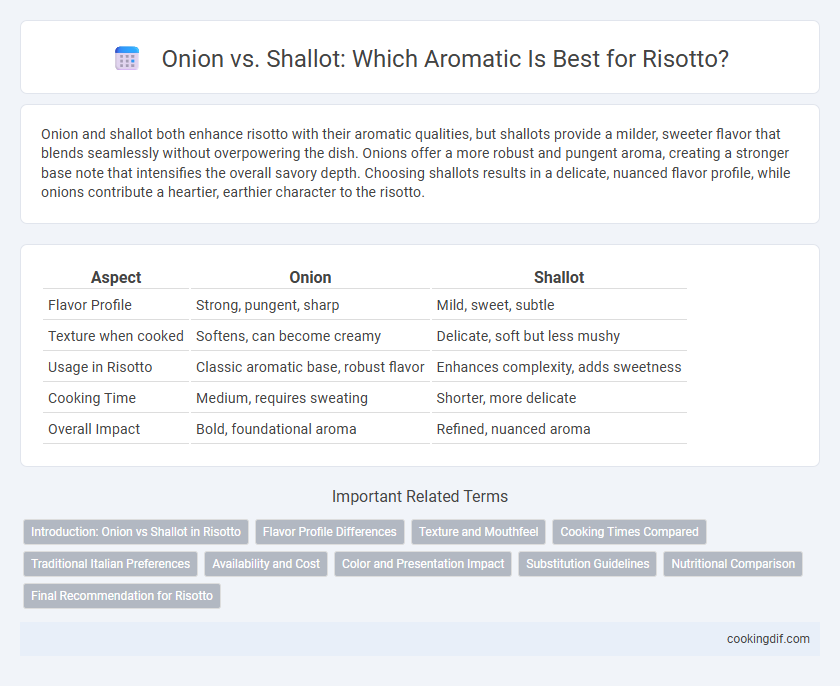Onion and shallot both enhance risotto with their aromatic qualities, but shallots provide a milder, sweeter flavor that blends seamlessly without overpowering the dish. Onions offer a more robust and pungent aroma, creating a stronger base note that intensifies the overall savory depth. Choosing shallots results in a delicate, nuanced flavor profile, while onions contribute a heartier, earthier character to the risotto.
Table of Comparison
| Aspect | Onion | Shallot |
|---|---|---|
| Flavor Profile | Strong, pungent, sharp | Mild, sweet, subtle |
| Texture when cooked | Softens, can become creamy | Delicate, soft but less mushy |
| Usage in Risotto | Classic aromatic base, robust flavor | Enhances complexity, adds sweetness |
| Cooking Time | Medium, requires sweating | Shorter, more delicate |
| Overall Impact | Bold, foundational aroma | Refined, nuanced aroma |
Introduction: Onion vs Shallot in Risotto
Onions provide a robust, slightly sweet base flavor essential for traditional risotto, while shallots offer a milder, more delicate aroma that enhances subtle complexity. Shallots dissolve more easily, contributing a smooth texture without overpowering the dish, making them ideal for refined risotto recipes. Choosing between onion and shallot depends on the desired flavor intensity and the risotto's overall profile.
Flavor Profile Differences
Onions offer a robust, slightly sweet base with a sharp undertone that intensifies during cooking, providing a hearty foundation for risotto. Shallots deliver a milder, more delicate flavor with subtle hints of garlic, adding complexity without overpowering the dish. Choosing shallots enhances the aromatic depth, while onions contribute a stronger, earthier character to the risotto.
Texture and Mouthfeel
Shallots offer a finer, more delicate texture compared to onions, enhancing risotto's smooth and velvety mouthfeel without overpowering other flavors. Their subtle sweetness and mild pungency dissolve more seamlessly, contributing a refined aromatic profile. Onions, with a coarser texture, may introduce slight graininess and a sharper bite, which can disrupt the creamy consistency essential to traditional risotto.
Cooking Times Compared
Shallots cook faster than onions, softening in about 3 to 5 minutes compared to onions' 5 to 7 minutes, making shallots a better choice when a quicker aromatic base is desired. Onions release a more robust, sweet flavor through longer caramelization, which benefits slower cooking processes like risotto. Choosing between them depends on whether the dish calls for rapid flavor infusion or a deep, mellow aroma developed over time.
Traditional Italian Preferences
Traditional Italian risotto recipes favor onions, particularly white or yellow varieties, for their robust and slightly sweet flavor that forms a classic aromatic base. Shallots, while milder and more delicate, are less common in authentic Italian cooking but may be used in regional variations to add subtle complexity. The choice influences the risotto's depth, with onions providing a more pronounced savory foundation.
Availability and Cost
Onions are widely available year-round and typically cost less than shallots, making them a budget-friendly choice for risotto aromatics. Shallots offer a milder, sweeter flavor but are often more expensive and less common in some grocery stores. Choosing onions enhances affordability and accessibility without compromising the foundational aroma of risotto.
Color and Presentation Impact
Using shallots in risotto results in a subtler, more delicate flavor and a lighter, translucent color that enhances the dish's presentation without overpowering it. Onions tend to produce a stronger aroma and darker hue, which can deepen the risotto's overall appearance but may mask more nuanced ingredients. Choosing shallots preserves the creamy, pale aesthetic typical of classic risotto while providing a refined aromatic profile.
Substitution Guidelines
When substituting onions with shallots in risotto, use one small shallot for every half medium onion to maintain a balanced flavor profile. Shallots provide a milder, sweeter taste with subtle garlic undertones, enhancing the dish's aromatic complexity without overpowering the creamy texture. Adjust cooking time slightly, as shallots saute faster due to their finer texture, ensuring they soften gently without browning.
Nutritional Comparison
Onions and shallots both enhance risotto with flavor, but their nutritional profiles differ significantly. Onions provide a higher amount of vitamin C and fiber, boosting immune health and digestion, while shallots contain more antioxidants and folate, supporting cellular function and heart health. Choosing between the two depends on desired nutritional benefits and flavor intensity in the dish.
Final Recommendation for Risotto
Shallots provide a milder, sweeter flavor compared to onions, enhancing risotto's delicate balance without overpowering the dish. Their subtle aroma melds seamlessly with the creamy texture and rich broth, making them ideal for traditional risotto recipes. For an authentic and refined taste, shallots are the preferred aromatic choice over onions.
Onion vs Shallot for aromatics Infographic

 cookingdif.com
cookingdif.com